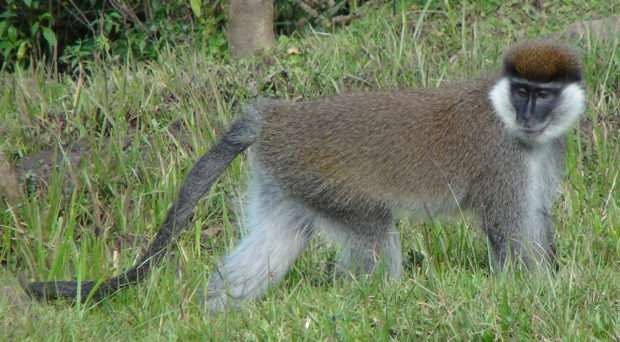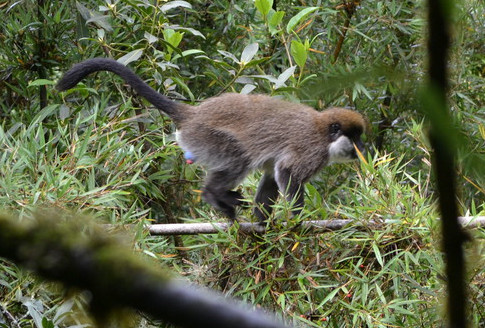
The Bale monkey (Chlorocebus djamdjamensis) is an tree-dwelling, rare primate species restricted to a small geographic range – less than 12,500 square kilometres – in the southern Ethiopian Highlands. Bale monkeys in intact forest habitats are bamboo specialist herbivores that rely on a single species of highland bamboo (Arundinaria alpina) accounting for 77-81% of their annual diet, which is mostly young leaves and shoots.
Habitat alteration and climate change are the major threats to biodiversity conservation, particularly for those specialist, rare species inhabiting small geographic ranges. These species are assumed to be less flexible at adapting to a changing environment than generalist species. Similar to other bamboo specialist mammals, such as giant pandas and bamboo lemurs, Bale monkeys are currently at high risk of extinction because of habitat alteration.
Bale monkeys are classified as a Vulnerable species by the IUCN Red List of Threatened Species with a total population size of less than 10,000 individuals and a general trend of population decline.

In addition to Bale monkeys, Ethiopia harbours two other Chlorocebus species: the vervet monkey (C. pygerythrus) and the grivet monkey (C. aethiops). These two species are widely distributed in Africa, semi-terrestrial ecological generalists, inhabiting a variety of habitats and consuming a diverse diet of plant species and invertebrates.
Studies have shown that understanding the population genetic structure of endangered species is essential to designing successful science-based management plans to ensure long-term survival. Thus, we aimed to investigate the genetic diversity and phylogeography of Bale monkey populations inhabiting continuous forest and forest fragments using mitochondrial DNA (mtDNA).
We collected a total of 119 Bale monkey faecal samples from May to December 2013 at three localities in continuous forest and nine localities in fragmented forests. We extracted, amplified and analysed mtDNA from these samples. We also included a total of 12 samples from other green monkeys in Ethiopia for the purpose of comparison.
Deep genetic differentiation
It was very surprising to find a strong and deep genetic differentiation between the Bale monkey populations inhabiting continuous forest and those inhabiting fragmented forests dating back 2.8 million years and corresponding to their geographic structuring.
There is strong and deep genetic differentiation between the Bale monkey populations inhabiting continuous forest and those inhabiting fragmented forests dating back 2.8 million years
Remarkably, Bale monkeys in fragmented forests are more closely related to their sister species (vervets and grivets) than their conspecifics in continuous forest, suggesting hybridization between Bale monkeys in forest fragments with vervets and grivets found in the surrounding region associated with habitat alteration.
Bale monkeys inhabiting intact bamboo forests of the Bale Mountains form monophyletic group, suggesting they are the source population of Bale monkeys and are not likely to be hybrids.
Bale monkey populations in continuous forest and forest fragments not only differ in their genetics but also in their ecology, morphology and gut microbiota. These differences further support the hypothesis that gene flow has already altered the gene pool of Bale monkey population in fragmented forests, making these monkeys ecologically flexible and more similar to other Chlorocebus species.

The future of Bale monkeys
As a result of a clear and deep genetic structuring between Bale monkey populations in continuous forest and forest fragments, we therefore propose two separate management units when implementing conservation strategies for Bale monkeys. For continuous forest Bale monkeys, we recommend improved protection of their intact bamboo forest habitat. For the fragmented forest population, we recommend connecting forest fragments to increase gene flow between isolated groups.
Overall, the results of this study increase our general understanding of how habitat fragmentation and hybridization together have shaped the genetic structure of the rare, range-restricted and bamboo-specialist Bale monkey.
We do acknowledge, however, that our genetic analysis should be interpreted with caution because we used a single and maternally inherited mtDNA locus that tells us only about the maternal history. Further research focusing on bi-parentally and paternally inherited genetic markers, as well as morphological and ecological studies is needed to understand the evolutionary history of this unusual species.
Comments